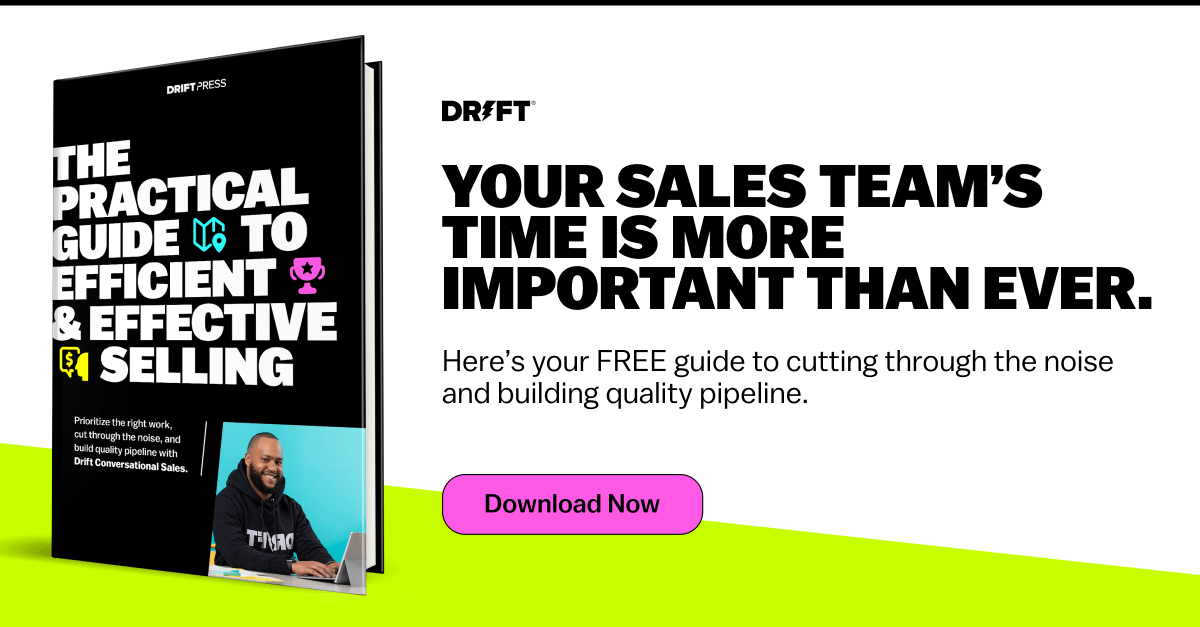Have you ever heard of “success reciprocity?” It’s when your success is someone else’s success and vice versa.
👆 This is the basis of every successful go-to-market relationship — be it internal or external.
Think about it: Your sales team’s success lies in the hands of your customers, which in turn, depends on how well you support them. In the same vein, a customer success manager’s success depends on how well an account executive understands that customer’s priorities.
But the root of all these successes can be found in the relationship between the account executive (AE) and the sales development rep (SDR).
To succeed in booking meetings and converting accounts into customers, SDRs and AEs need to be in lockstep with each other about everything — from what accounts to prioritize to the topics covered in a prospect’s first meeting. In other words, the success of both SDRs and AEs relies upon having a strong partnership between the two.
Just take it from one of Drift’s own AE and SDR pairs — Amanda Chiang and Gabby Marrocco. In an episode of our Conversation Starters podcast, hosted by Sammi Reinstein, Amanda and Gabby talked about how to form a partnership where everyone (including the customer) wins.
Here are their top three tips for building an SDR and AE partnership that drives success 👇
Tip #1: Get to Know Each Other Outside of Work
Before you can work effectively with your SDR or AE, it’s important you understand just who you’re working with. And this goes beyond names and job titles.
For Amanda and Gabby at the start of their partnership, this meant sitting down over a cup of coffee to talk about life — where they live, what they like to do outside of their nine-to-five, and what their career goals are.
And these conversations acted as the foundation for a good work relationship where Amanda and Gabby understand their strengths and priorities, and can openly communicate. As Gabby explained: “It’s all about establishing that initial relationship. … For me, it’s not awkward or doesn’t feel weird for me to give feedback or tell [Amanda] that, oh, she should reach out to this person. It just feels very natural.”
By getting to know the people you work with as people first, you’re better able to understand how they work and what’s most important to them. This knowledge will help you form a relationship built on trust and accountability — characteristics that will prove crucial as you work together to manage your top accounts.
Tip #2: Align on Your Top Accounts, Then Execute
It’s no secret that the end goal for an SDR is to book as many meetings as possible. But without a proper strategy in place, your SDR might end up running around like a chicken with its head cut off.
That’s why it’s so important for AEs and SDRs to be aligned on which accounts should take priority. When the SDR understands which accounts are top-of-mind for the AE, they’re able to manage their time better and book the meetings that matter most.
For Amanda and Gabby, the foundation of their success has been working together to figure out who their top accounts are — largely by looking at a prospect’s tech stack or identifying accounts whose websites have a lot of friction.
From there, they divide and conquer when reaching out to those accounts. “I think it’s really empowering to just give your SDR a lot of that ownership,” Amanda said. “But it’s my responsibility to come in and see who can I maybe craft messages that are a little bit different than Gabby, in a different channel, that would be attacking from different angles.”
Tip #3: Stay in Constant Communication
Once you’ve learned how your teammate likes to work, you’re aligned on which accounts to prioritize, and you’re busy reaching out to potential customers, it’s critical to not let up on communication.
Amanda and Gabby have found that a weekly Zoom meeting is great for mutual accountability. Each Monday, they connect for 30 minutes to assess where they are in their prospecting and decide on where they need to go from there.
Besides that, Amanda and Gabby are constantly giving each other the 411 through Slack, and that’s where they’ll communicate if an account is showing signs of buying intent or if they’ve booked a meeting.
And after Gabby books a meeting with a prospect, she passes over all her email chains, phone recordings, and chats with the account to Amanda. With those conversations in hand, Amanda can provide a relevant and personalized experience from the very first meeting. This way, the buyer doesn’t feel like they’re starting the conversation from scratch.
Final Thought
Sales has been, and always will be, a team sport.
And nowhere is team spirit more important than with your AEs and SDRs. Because when your AEs and SDRs are aligned from the very first touch (and even before that), they can collaborate to create a personalized experience that drives more efficient interactions and delights buyers — which means everyone wins.
So, the next time you jump on a call with your AE or SDR, don’t go straight into the action items. Take a second to learn something new about your teammate, make sure you’re aligned on your strategy, and then think about how you can tag-team those accounts.
By aligning and communicating often, you will have no problem building a strong SDR and AE relationship that will put you, your teammates, and your customers all on the road to success.









